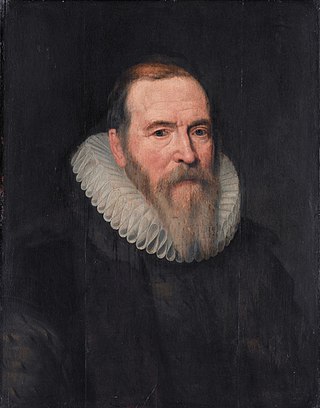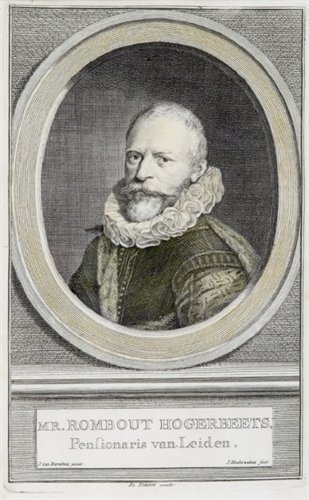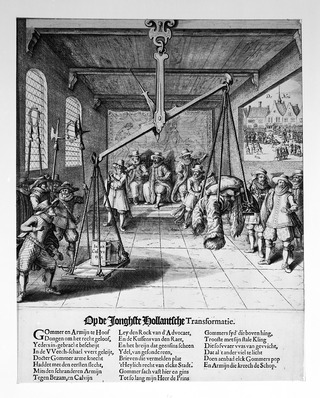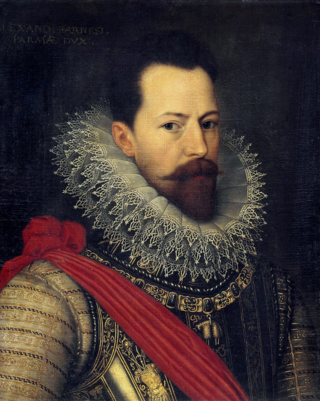
The United Provinces of the Netherlands, officially the Republic of the Seven United Netherlands, and commonly referred to in historiography as the Dutch Republic, was a confederation that existed from 1579 until the Batavian Revolution in 1795. It was a predecessor state of the present-day Netherlands. The republic was established after seven Dutch provinces in the Spanish Netherlands revolted against Spanish rule, forming a mutual alliance against Spain in 1579 and declaring their independence in 1581. It comprised Groningen, Frisia, Overijssel, Guelders, Utrecht, Holland and Zeeland.
The Union of Utrecht was a treaty signed on 23 January 1579 in Utrecht, Netherlands, unifying the northern provinces of the Netherlands, until then under the control of Habsburg Spain.

Hugo Grotius, also known as Huig de Groot and Hugo de Groot, was a Dutch humanist, diplomat, lawyer, theologian, jurist, poet and playwright. A teenage prodigy, he was born in Delft and studied at Leiden University. He was imprisoned in Loevestein Castle for his involvement in the intra-Calvinist disputes of the Dutch Republic, but escaped hidden in a chest of books that was transported to Gorinchem. Grotius wrote most of his major works in exile in France.

Maurice of Orange was stadtholder of all the provinces of the Dutch Republic except for Friesland from 1585 at the earliest until his death in 1625. Before he became Prince of Orange upon the death of his eldest half-brother Philip William in 1618, he was known as Maurice of Nassau.

Albert VII was the ruling Archduke of Austria for a few months in 1619 and, jointly with his wife, Isabella Clara Eugenia, sovereign of the Habsburg Netherlands between 1598 and 1621. Prior to this, he had been a cardinal, Archbishop of Toledo, viceroy of Portugal and Governor General of the Habsburg Netherlands. He succeeded his brother Matthias as reigning archduke of Lower and Upper Austria, but abdicated in favor of Ferdinand II the same year, making it the shortest reign in Austrian history.

Johan van Oldenbarnevelt, Heer van Berkel en Rodenrijs (1600), Gunterstein (1611) and Bakkum (1613) was a Dutch statesman and revolutionary who played an important role in the Dutch struggle for independence from the Habsburg Castilian Empire.

The Eighty Years' War or Dutch Revolt (c.1566/1568–1648) was an armed conflict in the Habsburg Netherlands between disparate groups of rebels and the Spanish government. The causes of the war included the Reformation, centralisation, taxation, and the rights and privileges of the nobility and cities.

The Peace of Münster was a treaty between the Lords States General of the Seven United Netherlands and the Spanish Crown, the terms of which were agreed on 30 January 1648. The treaty, parallelly negotiated to but not part of the Peace of Westphalia, is a key event in Dutch history, marking the formal recognition of the independent Dutch Republic and the end of the Thirty Years' War and the Eighty Years' War.
The Treaty of Antwerp, which initiated the Twelve Years' Truce, was an armistice signed in Antwerp on 9 April 1609 between Spain and the Netherlands, creating the major break in hostilities during the Eighty Years' War for independence conducted by the Seventeen Provinces in the Low Countries.

In the history of the Dutch Republic, Orangism or prinsgezindheid was a political force opposing the Staatsgezinde (pro-Republic) party. Orangists supported the Princes of Orange as Stadtholders and military commanders of the Republic, as a check on the power of the regenten. The Orangist party drew its adherents largely from traditionalists – mostly farmers, soldiers, noblemen and orthodox Protestant preachers, though its support fluctuated heavily over the course of the Republic's history and there were never clear-cut socioeconomic divisions.

Gilles van Ledenberg was a Dutch statesman. He was secretary of the States of Utrecht from 1588 until his arrest for treason in 1618, together with Johan van Oldenbarnevelt. He committed suicide to prevent forfeiture of his assets, but he was sentenced to death posthumously and posthumously executed.

Rombout Hogerbeets was a Dutch jurist and statesman. He was tried for treason, together with Johan van Oldenbarnevelt, Hugo Grotius, and Gilles van Ledenberg during the political crisis of 1617–18 in the Dutch Republic, and sentenced to life-imprisonment. He shared Loevestein prison with Grotius.

The Sharp Resolution was a resolution taken by the States of Holland and West Friesland on 4 August 1617 on the proposal of the Land's Advocate of Holland, Johan van Oldenbarnevelt, in the course of the Arminian-Gomarist, or Remonstrant/Counter-Remonstrant controversy that was disturbing the internal politics of the Dutch Republic during the Twelve Years' Truce. The resolution brought serious disagreements about the interpretation of the Union of Utrecht, that had long simmered, into focus. It started a political conflict that eventually brought down the Oldenbarnevelt-regime and led to Oldenbarnevelt's arrest on 29 August 1618, together with his colleagues Hugo Grotius, Rombout Hogerbeets, and Gilles van Ledenberg, and their 1619 trial, which resulted in their conviction of high treason, and Oldenbarnevelt's execution on 13 May 1619.

The Trial of Oldenbarnevelt, Grotius and Hogerbeets was the trial for treason of Johan van Oldenbarnevelt, Land's Advocate of Holland, Hugo Grotius, pensionary of Dordrecht, Rombout Hogerbeets, pensionary of Leiden, and their co-defendant Gilles van Ledenberg, secretary of the States of Utrecht by an ad hoc court of delegated judges of the States General of the Netherlands that was held between 29 August 1618 and 18 May 1619, and resulted in a death sentence for Oldenbarnevelt, and sentences of life in prison for Grotius and Hogerbeets. The trial was and is controversial for political and legal reasons: political, because it put the crown on the Coup d'etat of stadtholder Maurice, Prince of Orange and his partisans in the States General of the Dutch Republic that ended the previous Oldenbarnevelt regime and put the Orangist party in power for the time being; legal, because the trial deprived the defendants of their civil rights under contemporary law, and the judges changed both the "constitution" of the Republic and its laws in an exercise of ex post facto legislation.
Benjamin Aubery du Maurier was a French huguenot statesman and ambassador of his country to the States General of the Dutch Republic during the "Truce Quarrels". He tried in vain to save the life of Dutch statesman Johan van Oldenbarnevelt after he was sentenced to death in the Trial of Oldenbarnevelt, Grotius and Hogerbeets.

The Ten Years were a period in the Eighty Years' War spanning the years 1588 to 1598. In this period of ten years, stadtholder Maurice of Nassau, the future prince of Orange and son of William "the Silent" of Orange, and his cousin William Louis, Count of Nassau-Dillenburg and stadtholder of Friesland as well as the English general Francis Vere, were able to turn the tide of the war against the Spanish Empire in favour of the Dutch Republic. They achieved many victories over the Spanish Army of Flanders, conquering large swathes of land in the north and east of the Habsburg Netherlands that were incorporated into the Republic and remained part of the Netherlands into the present. Starting with the important fortification of Bergen op Zoom (1588), Maurice and William Louis subsequently took Breda (1590), Zutphen, Deventer, Delfzijl, and Nijmegen (1591), Steenwijk, Coevorden (1592) Geertruidenberg (1593), Groningen (1594), Grol, Enschede, Ootmarsum, and Oldenzaal (1597)., recovering territories lost in 1580 through the treachery of George de Lalaing. Maurice's most successful years were 1591 and 1597, in which his campaigns resulted in the capture of numerous vital fortified cities, some of which were regarded as "impregnable". His novel military tactics earned him fame amongst the courts of Europe, and the borders of the present-day Netherlands were largely defined by the campaigns of Maurice of Orange during the Ten Years.

The years 1621–1648 constituted the final phase of the Eighty Years' War between the Spanish Empire and the emerging Dutch Republic. It began when the Twelve Years' Truce (1609–1621) expired, and concluded with the Peace of Münster in 1648.

The years 1599–1609 constituted a phase of in the Eighty Years' War between the Spanish Empire and the emerging Dutch Republic. It followed the Ten Years (1588–1598) that saw significant conquests by the Dutch States Army under the leadership of stadtholders Maurice of Nassau and William Louis of Nassau-Dillenburg, and ended with the conclusion of the Twelve Years' Truce (1609–1621) on 9 April 1609. The 1599–1609 period was generally marked by a stalemate; the well-known Battle of Nieuwpoort (1600) brought the Dutch a tactical victory without long-term gain, while Spanish conquests in the Siege of Ostend (1601–1604) and Spinola's 1605–1606 campaign were effectively balanced out by the Dutch naval triumph in the Battle of Gibraltar (1607) and the Spanish state bankruptcy that same year. Financial troubles were amongst the primary motives that prompted the Dutch, and even more so the Spanish, to head to the negotiating table for a ceasefire.

The years 1579–1588 constituted a phase of in the Eighty Years' War between the Spanish Empire and the United Provinces in revolt after most of them concluded the Union of Utrecht on 23 January 1579, and proceeded to carve the independent Dutch Republic out of the Habsburg Netherlands. It followed the 1576–1579 period, in which a temporary alliance of 16 out of the Seventeen Provinces' States–General established the Pacification of Ghent as a joint Catholic–Protestant rebellion against the Spanish government, but internal conflicts as well as military and diplomatic successes of the Spanish Governors-General Don Juan of Austria and Alexander Farnese, Duke of Parma split them apart, finally leading the Malcontent County of Artois, County of Hainaut and city of Douai to sign the Union of Arras on 6 January 1579, reverting to Catholicism and loyalty to the Spanish crown. In response, most of the remaining rebel provinces and cities would forge or later accede to the Union of Utrecht, a closer military alliance treaty that would go on to become the most important fundamental law of the United Provinces, who on 26 July 1581 proclaimed the Act of Abjuration, a de facto declaration of independence from Spain. While the nascent polity was struggling to find a new sovereign head of state, including Matthias of Austria, Francis of Anjou, William "the Silent" of Orange and Robert of Leicester, before giving up and deciding to become a republic by passing the Deduction of Vrancken on 12 April 1588, the Duke of Parma continued his successful military and diplomatic offensive, bringing ever more provinces and cities in the southern, eastern and northeastern parts of the Netherlands back into royalist hands. Parma's reconquests more or less stalled after the Fall of Antwerp (1585), and finally came to an end with the failure of the Spanish Armada and Philip II ordered him to intervene in the French Wars of Religion to prevent the Succession of Henry IV and France becoming a Protestant kingdom. These developments gave rise to a new phase, the Ten Years (1588–1598), that saw significant conquests by the Dutch States Army under the leadership of stadtholders Maurice of Nassau and William Louis of Nassau-Dillenburg, and the Dutch Republic's rise as a commercial great power.
The historiography of the Eighty Years' War examines how the Eighty Years' War has been viewed or interpreted throughout the centuries. Some of the main issues of contention between scholars include the name of the war, the periodisation of the war, the origins or causes of the war and thus its nature, the meaning of its historical documents such as the Act of Abjuration, and the role of its central characters such as Philip II of Spain, William "the Silent" of Orange, Margaret of Parma, the Duke of Alba, the Duke of Parma, Maurice of Orange, and Johan van Oldenbarnevelt. It has been theorised that Protestant Reformation propaganda has given rise to the Spanish Black Legend in order to portray the actions of the Spanish Empire, the Army of Flanders and the Catholic Church in an exaggerated extremely negative light, while other scholars maintain that the atrocities committed by the Spanish military in order to preserve the Habsburg Netherlands for the Empire have historically been portrayed fairly accurately. Controversy also rages about the importance of the war for the emergence of the Dutch Republic as the predecessor of the current Kingdom of the Netherlands and the role of the House of Orange's stadtholders in it, as well as the development of Dutch and Belgian national identities as a result of the split of the Northern and Southern Netherlands.
























